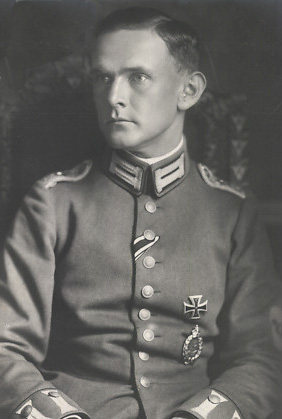Related Research Articles

LeutnantKarl Allmenröder was a German World War I flying ace credited with 30 aerial victories. The medical student son of a preacher father was seasoned in the trenches as an 18-year-old artilleryman in the early days of the First World War, earning promotion via battlefield commission to Leutnant on 30 March 1915. After transferring to aviation and serving some time as an artillery spotter in two-seater reconnaissance airplanes, he transferred to flying fighter aircraft with Jagdstaffel 11 in November 1916. As Manfred von Richthofen's protege, Karl Allmenröder scored the first of his 30 confirmed victories on 16 February 1917. Flying a scarlet Albatros D.III trimmed out with white nose and elevators, Allmenröder would score a constant string of aerial victories until 26 June 1917, the day before his death. On 27 June 1917, Karl Allmenröder fell to his death near Zillebeke, Belgium. His posthumous legacy of patriotic courage would later be abused as propaganda by the Nazis.

Adolf Ritter von Tutschek (16 May 1891 – 15 March 1918) PlM, MOMJ was a professional soldier turned aviator. As German air strategy turned towards concentrated air power, he was entrusted with one of the world's first fighter wings.
Leutnant Hermann Becker, was a World War I German flying ace credited with 23 victories.
Leutnant Hans-Georg August von der Osten began his career as a World War I flying ace credited with five aerial victories. He later rose to command of all Luftwaffe bases in Germany, during World War II.
LeutnantTheodor Rumpel was a World War I flying ace credited with five aerial victories.

Leutnant Hans Imelmann was a World War I flying ace credited with six aerial victories. As a founding member of one of Germany's original fighter squadrons, he was shot down and killed before he reached his twentieth birthday.
Vizefeldwebel Max Kahlow was a German World War I flying ace credited with six aerial victories.

Leutnant Kurt Küppers was a World War I flying ace credited with six aerial victories.
Leutnant Fritz Gerhard Anders was a World War I flying ace credited with seven aerial victories. He was the world's first night fighter ace.
Leutnant Kurt Adolf Monnington (1891–1939) was a World War I flying ace credited with eight aerial victories.
Leutnant Wolfgang Güttler was a World War I flying ace credited with eight aerial victories. He would score the first four while flying with Jagdstaffel 24, and the last four while flying as commander of Jagdstaffel 13. He was killed in a midair collision over his home airfield on 20 February 1918.

Leutnant Hartmuth Baldamus was a German World War I flying ace credited with 18 aerial victories.
LeutnantWalter Böning was a German World War I flying ace from the Grand Duchy of Oldenburg credited with 17 aerial victories. He began his World War I military service as an infantryman. He distinguished himself by winning both the Gold Medal for Bravery and the Second Class Iron Cross. He then transferred to aviation duty, training originally as a reconnaissance pilot before advancing to become a fighter pilot. Between 6 April 1917 and 30 May 1918, he was credited with 17 aerial victories. On 31 May 1918, he survived a midair collision while being attacked by British fighters. Although he coaxed his damaged machine home, the serious leg wound he had suffered sidelined him through war's end.
Leutnant Ernst Hess HOH IC was a World War I flying ace credited with 17 confirmed and four unconfirmed aerial victories. Hess was one of a few World War I pilots involved in aviation prewar, as he gained his civil pilot's license on 26 September 1913. He was already enrolled in Die Fliegertruppen of the Imperial German Army when World War I began. He qualified for his military pilot's license on 21 November 1914, and was launched on his flying career as one of Germany's first fighter pilots. He would score his first aerial victory in tandem with Oswald Boelcke on 5 January 1916. He would rotate through four assignments before scoring a dozen victories within July–September 1917 while flying an Albatros D.Va for Jagdstaffel 28. On 19 September 1917, he was promoted to command of Jagdstaffel 19. He had just been appointed to command of a Jagdgruppe being formed by Germany's First Army when he was killed in combat on 23 December 1917.
LeutnantFranz Piechulek was a German World War I flying ace credited with 14 aerial victories.
Leutnant Johannes Max Janzen was a World War I flying ace credited with thirteen aerial victories. He returned to Germany's military service during World War II, and died in a Russian prison camp on 18 October 1945.
Leutnant Heinrich Arntzen was a German World War I flying ace credited with eleven aerial victories.
LeutnantHermann Pfeiffer IC was a German World War I flying ace credited with eleven aerial victories.
Leutnant Hans von Keudell was a World War I flying ace credited with twelve aerial victories.
Leutnant Hanns Joachim Wolff was a World War I German flying ace credited with ten aerial victories.
References
- Franks, Norman; Bailey, Frank W.; Guest, Russell. Above the Lines: The Aces and Fighter Units of the German Air Service, Naval Air Service and Flanders Marine Corps, 1914–1918. Grub Street, 1993. ISBN 0-948817-73-9, ISBN 978-0-948817-73-1.